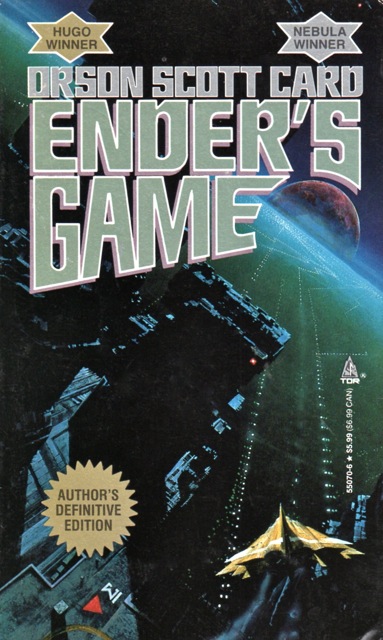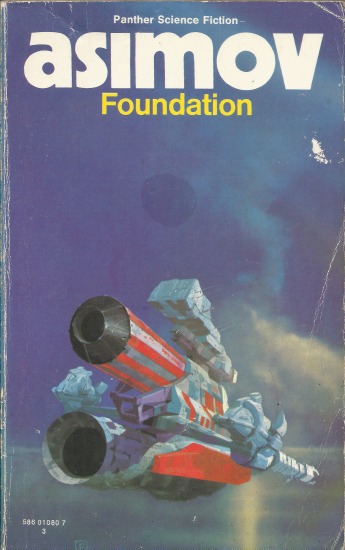User:ErsatzCulture/ARantAboutCoverDesignAndArt
This follows on from discussion on the Rules & standards page in early 2021 (so that link will break once those discussions have been moved to an archive page.)
So, here are some covers that I don't think anyone will have any objections about their inclusion in the database:
(Sorry for not scaling these down - I tried doing that with |200px| in the wiki link, but this just causes an error reporting that the ImageMagick "convert" utility isn't installed.)
I've included two versions of Ender's Game and two Asimov covers in part to make the point that the differences in first pair, and the common "asimov" logo and typography in the latter pair, are examples of "design" that (I imagine) are the sort of thing that isn't cared about in ISFDB, and why there's the "COVERART is not for design" rule.
Anyway, here's a more modern cover, the US edition of Alastair Reynolds' Shadow Captain. (This is an Amazon image, so I'm not sure it's OK to hotlink from the Wiki as opposed to the main site.) This is credited to Blacksheep and Lauren Panepinto, but if we look at the PVed pub, it states "Design by Blacksheep & Lauren Panepinto is on the copyright page and the back cover." As such, per the rules, this shouldn't have COVERART credits, but let's put that to one side for the moment...
Here's the UK cover, which has been scanned, and so is safe to link directly on the Wiki:
This pub is also PVed, and the note states "On inside of back dust jacket slip: Designed by www.blacksheep-uk.com / Cover photo: © Shutterstock / Depositphotos". The lack of a credit to Lauren Panepinto (who is [http://www.isfdb.org/cgi-bin/ea.cgi?137280 "Creative Director" at Orbit in New York, whereas the UK pub is from Gollancz) likely indicates that she was responsible for the different typefaces on the US cover, which (IMHO) falls into the sort of design that shouldn't be given a COVERART record.
However, the lack of the "Cover photo: © Shutterstock / Depositphotos" text on the US pub might indicate that this element wasn't considered a priority credit to Orbit US, despite that being closest to what ISFDB rules say COVERART should be used for. (As an aside, none of the 3 PVs of the UK pub have added a COVERART credit for this cover, I dunno what that their thoughts/preferences are.)
Anyway, I'd argue that Black Sheep being the only entity credited on both US and UK pubs means they are probably the prime creative force behind this cover, and indeed, it's on their SF portfolio page. (Another aside: how many of those covers are legit COVERART, and how many are "merely" design?) Clearly they were the ones ultimately responsible for the underlying image - how does that differ from the Harris or Foss images at the top of this page?
Now, the reason I picked this image, is that the core spaceship isn't something they created. Here are some more covers that use the same primary image:
- 2018 UK and 2018 US editions of Neil Asher's Brass Man - the latter has a COVERART credit to Steve Stone based on info from Locus. Note: when I checked a copy of Locus (which I only buy once or twice a year), it seemed they only credit as "cover by", not design or art. This could mean that a large chunk of the Locus-derived COVERART credits in the database violate the rules.
- 2015 UK pub of John Scalzi's Zoe's Tale. No credit logged in ISFDB (and I don't think it's listed in my ebook copy), but I suspect it's another Black Sheep offering
- Alex White's A Big Ship at the Edge of the Universe (look at the bottom of the image) - no COVERART record but note states "Cover design by Lisa Marie Pompilio / Cover art by Shutterstock"
(I have about half-a-dozen other uses of this CG spaceship, in the notes I've been maintaining for a personal project in mind, in case you can't tell ;-)
So, what's the point I'm making?
Erm, not sure?!? I think it's that having a rule saying only COVERART gets "properly" recorded is going to miss out a large chunk of modern speculative fiction covers. e.g. if we look at Orbit (US)'s 2020 covers, I'd suspect that 2020 are design rather than art led, and I believe they're the second biggest publisher after Tor.
In the process of prepping these notes, I found this pay video entitled "HOW A BOOK COVER IS DESIGNED", seemingly presented by the aforementioned Lauren Panepinto. I haven't watched it, and I don't expect anyone else reading this to either, but this intro blurb I think backs up my point in the previous paragraph (my emphasis):
- While Muddy Colors usually focuses on book covers utilizing a freelance illustrator, this demo will show the other half of book covers – ones fully designed in house using designer-created and/or found imagery.
This screengrab from the video also breaks roles down into 5 categories:
- Creative Director
- Art Director
- Designer
- Assistant
- Freelancer (covering illustrator, photographer, designer)
It feels to me like COVERART is only aiming to handle the "illustrator" (sub)case?
Finally, I think the masterclass.com text that Ahasuerus linked to is more of a simplified Platonic ideal to make things easier to teach, than an accurate reflection of how publishing/creatives work [*]. Much of that stuff isn't a cover designer's job, more of an art director/creative director/art lead, I'd say. (Note that the aforementioned Panepinto is a creative director at Orbit.) Also, I (in part) picked the 4 images at the top of this page because IMHO they contradict the info on that masterclass.com page about how exactly covers are produced, but this rant is long enough already, so I'll leave it for the reader to work out why I think that ;-)
[* - I'm basing that statement on 10 years working in newspaper production, and another 5 in creative and advertising agency environments - not book publishing, but reasonably adjacent to it. I'll happily defer to anyone with more direct experience.]
Ahasuerus summarized that as "the cover artist produces the picture which appears on the cover." - yet per what I wrote above, Black Sheep produced the image that appears on the cover of Shadow Captain, but are credited with design, not art.




